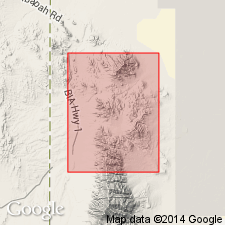
- Usage in publication:
-
- Manning Canyon formation*
- Modifications:
-
- Areal extent
- AAPG geologic province:
-
- Great Basin province
Summary:
Represents a westward extension of name into the Gold Hill quad, western Tooele Co, UT in the Great Basin province. Composed of dark quartzite, sandy shale, and black shale. Limestone beds found locally. Thickness varies from a few ft to 1,000+ ft. Is fossiliferous. Assigned a Mississippian? and Pennsylvanian (Pottsville) age.
Source: GNU records (USGS DDS-6; Denver GNULEX).
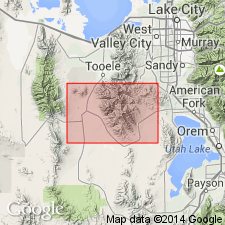
- Usage in publication:
-
- Manning Canyon shale*
- Modifications:
-
- Named
- Dominant lithology:
-
- Shale
- Limestone
- AAPG geologic province:
-
- Wasatch uplift
- Great Basin province
Summary:
Named for exposures in Manning Canyon, Utah Co, UT on the Wasatch uplift. Extends westward into Tooele Co, UT in the Great Basin province. Mapped as a band between the upper limestone of the Great Blue limestone and the base of the newly named Oquirrh formation. No type locality designated. Rocks assigned were included in the upper part of the original Great Blue limestone. Forms valleys. Is impervious to water, hence many springs in the valleys. Exposures are poor. Lower contact exposed in a few places. Contact with underlying Great Blue is gradational over 200 to 300 ft; contact placed at base of a predominantly shale section. Section 1,140 ft thick measured in Soldier Canyon, north of Ophir in Tooele Canyon. Consists of interbedded dark-gray to black shale; gray, thin-bedded, ledge-forming limestone; and one brown-weathering quartzite conformably below the Oquirrh and the measured section. Ranges from 750 ft thick west of Lewiston Peak to 1,140 ft thick at Hall Canyon and Soldier Creek. Fossils of Chester and Pennsylvanian age listed (pelecypods, brachiopods, etc.). Assigned to the Mississippian and Pennsylvanian. Stratigraphic chart.
Source: GNU records (USGS DDS-6; Denver GNULEX).
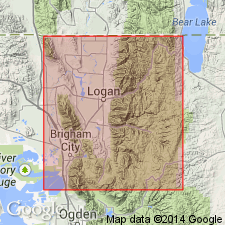
- Usage in publication:
-
- Manning Canyon formation
- Modifications:
-
- Contact revised
- AAPG geologic province:
-
- Wasatch uplift
Summary:
Upper contact revised in that Manning Canyon formation underlies the newly named West Canyon Limestone Member, basal member of Oquirrh formation in Cache and Utah Cos., UT on the Wasatch uplift. The Manning Canyon-West Canyon contact as described is a calcareous bleached siltstone (Manning Canyon) overlain by dark gray calcisiltite or calcilutite (West Canyon). Of Mississippian and Pennsylvanian age.
Source: GNU records (USGS DDS-6; Denver GNULEX).
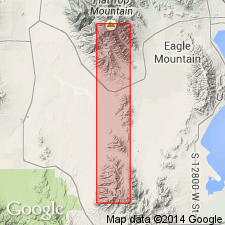
- Usage in publication:
-
- Manning Canyon shale
- Modifications:
-
- Contact revised
- AAPG geologic province:
-
- Wasatch uplift
- Great Basin province
Summary:
Upper contact revised in that Manning Canyon shale underlies the newly named Hall Canyon member of Morrowan age, basal member of the Oquirrh formation. Contact is transitional. Contact placed where limestones or locally where calcareous orthoquartzites (Hall Canyon) predominate over black and brown shales (Manning Canyon). Mapped on two geologic maps as a Pennsylvanian and Mississippian unit above the Great Blue limestone, but no other descriptive information concerning the Manning Canyon included in report. Mapped in the southern Oquirrh Mountains area, and Fivemile Pass and northern Boulter Mountain quads., Utah Co. (Wasatch uplift) and Tooele Co. (Great Basin province), UT.
Source: GNU records (USGS DDS-6; Denver GNULEX).
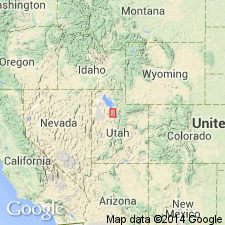
- Usage in publication:
-
- Manning Canyon Shale*
- Modifications:
-
- Revised
- AAPG geologic province:
-
- Wasatch uplift
Summary:
Revised in that Manning Canyon Shale underlies the West Canyon Limestone (revised from West Canyon Limestone Member of Oquirrh Formation), basal formation of the Oquirrh Group (rank raised) in Bingham Canyon area, Utah Co, UT on the Wasatch uplift. Of Late Mississippian age.
Source: GNU records (USGS DDS-6; Denver GNULEX).
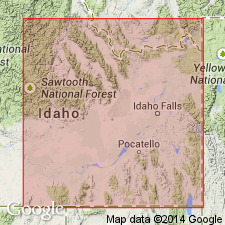
- Usage in publication:
-
- Manning Canyon Shale*
- Modifications:
-
- Age modified
- AAPG geologic province:
-
- Great Basin province
Summary:
Age of the Manning Canyon Shale is revised from Late Mississippian and Early Pennsylvanian to: Late Mississippian to Middle Pennsylvanian.
Source: GNU records (USGS DDS-6; Menlo GNULEX).
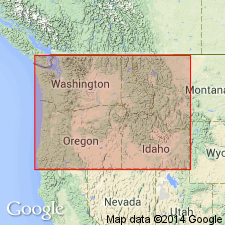
- Usage in publication:
-
- Manning Canyon Shale*
- Manning Canyon Formation
- Modifications:
-
- Geochronologic dating
- AAPG geologic province:
-
- Great Basin province
Summary:
Pg. 12, 13, geologic time scale (inside front cover). Manning Canyon Shale and Manning Canyon Formation (Mississippian and Pennsylvanian). Nine samples from carbonaceous argillites in Manning Canyon Shale, in the Black Pine Mountains area, Strevell 15-min quadrangle, Cassia County, Idaho. The Manning Canyon is part of an allochthonous block in this area; samples were dated by K-Ar method in an attempt to define time of thrusting event. In the northern third of Black Pine Mountains these rocks reached temperatures of 190 to 300 deg. C and in the southern portion they reached temperatures of 300 to 400 deg. C; as indicated by Conodont Color Alteration Indices (CAI) (see J.F. Smith, 1983, USGS Bull. 1536). This thermal regime would have reset the K-Ar ages of minerals in the sedimentary rocks, and if this thermal regime was the result of thrusting, then the youngest K-Ar ages may indicate the approximate time of the last thrusting event. K-Ar ages range from Early to Late Cretaceous; a 35 m.y. spread. Two hypotheses for this age range: (1) the sediments have been deeply buried and thus entered a zone of elevated temperatures for an extended time; they were then uplifted and/or thrust-faulted and exposed about 100 to 70 Ma; (2) sediments were affected by a thermal regime that accompanied the thrust-faulting about 90 to 80 Ma. At present time, evidence is inconclusive to substantiate either hypothesis. K-Ar ages (whole-rock): 111 +/-4 Ma, 107 +/-4 Ma, 104 +/-6 Ma, 102 +/-4 Ma, 99.0 +/-3.4 Ma, 98.4 +/-3.3 Ma, 93.1 +/-3.2 Ma, 85.9+/-2.9 Ma, and 76.6 +/-2.6 Ma. Decay constants of Steiger and Jager, 1977 (Earth Planet. Sci. Letters, v. 36, p. 359-362) are used.
Source: Publication.

- Usage in publication:
-
- Manning Canyon Shale*
- Modifications:
-
- Contact revised
- AAPG geologic province:
-
- Great Basin province
Summary:
Upper contact revised in the Chesterian Manning Canyon Shale underlies: 1.) the newly named Bannock Peak Limestone, basal formation of the Oquirrh Group in southeast ID, and 2.) the West Canyon Limestone, basal formation of the Oquirrh Group in the Grassy, Cedar, Stansbury, Lake, Timpanogos, and southern Oquirrh Mountains of north-central UT. Bannock Peak replaces use of West Canyon in southeast ID. Area studied lies in the Great Basin province.
Source: GNU records (USGS DDS-6; Denver GNULEX).
For more information, please contact Nancy Stamm, Geologic Names Committee Secretary.
Asterisk (*) indicates published by U.S. Geological Survey authors.
"No current usage" (†) implies that a name has been abandoned or has fallen into disuse. Former usage and, if known, replacement name given in parentheses ( ).
Slash (/) indicates name conflicts with nomenclatural guidelines (CSN, 1933; ACSN, 1961, 1970; NACSN, 1983, 2005, 2021). May be explained within brackets ([ ]).

